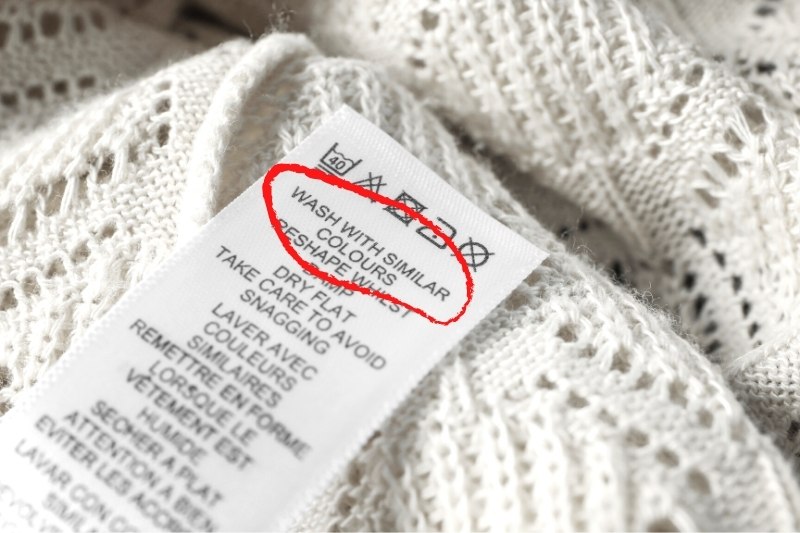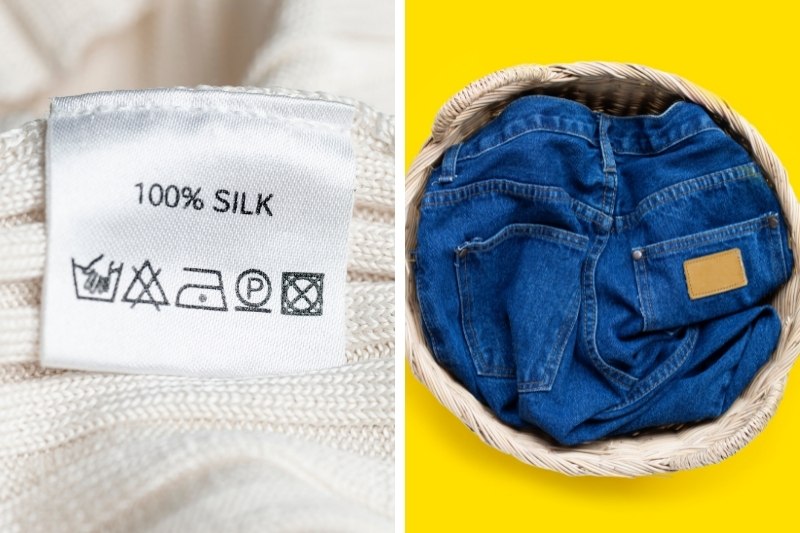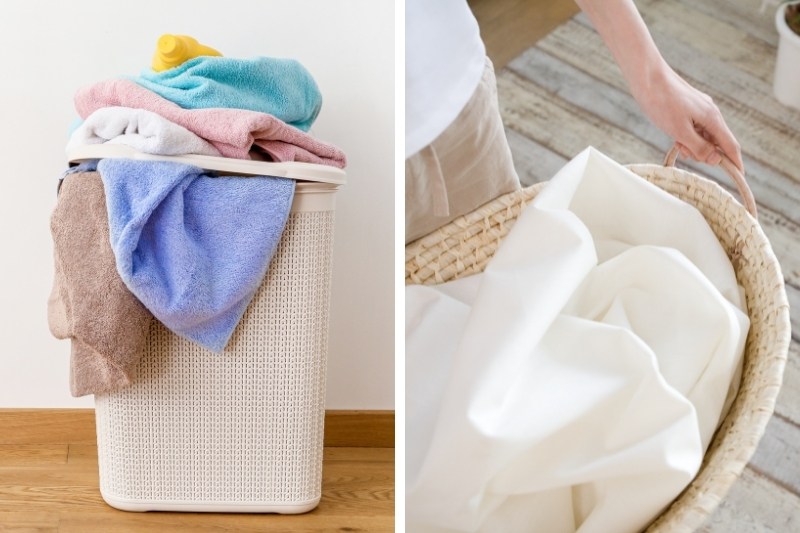Have you been told recently that you need to sort out your laundry into separate washing piles before you start cleaning your clothes? If so, you’re probably wondering how on earth you split your laundry up…
Do you do it by weight, colour, material, or is there another special way to separate your laundry?
The truth is that there are a number of different ways you can split up your pile of laundry. Find out how you can separate your laundry below!
Why Should You Separate Your Laundry?
Before I go into detail about how to separate your laundry ready for washing, I think it’s important that you know why you need to do this. After all, splitting up dirty laundry into various piles isn’t exactly the greatest activity in the world, not to mention that it’s time consuming. Nonetheless, you shouldn’t skip this phase because…
- It’ll help your clothes in the long run because you’ll be washing them in the way they should be washed – For example, delicates will be washed on a delicate cycle.
- If you keep all your clothes in coloured piles you can prevent any accidental dye runs from happening – For example, if you put a red sock in with a pile of white clothes, you’ll end up with pink items, but this can be prevented if you separate your laundry properly.
- Hygiene reasons – For example, you can keep your underwear in one pile, and your everyday clothes in another to prevent the spread of germs.
- You won’t be mixing up all your different materials together – For example, you can separate your delicate silk tops from your accessorised jeans, and this will prevent snagging and any other irreparable damage from occurring.
5 Ways to Separate Laundry
Note: If you’re new to the separating laundry scene you should start with the easiest option(s) first. A lot of people think that separating laundry by checking clothes labels and separating clothes by colour are some of the easiest ways to split up laundry piles. Although you should pick out the option(s) that best suit you and your home.
And don’t forget, you’ll likely use a mix of the options below when you get more comfortable with sperapting your laundry.
1. Separating laundry by checking clothing labels

One of the best ways you can split your dirty laundry up is by reading the tags on every single item that you intend on washing, and splitting the garments up into similar piles of washing.
The clothing care tag will provide you with lots of key information, like what the item is made from, how to wash it and how to dry it, so you can separate the clothes based on what the tags say.
You may end up with lots of piles, like a delicate pile, a hand wash only pile and a cotton pile by the end of this exercise.
Of course, this option may be time consuming to start off with, but it is worth it because you’ll be washing similar clothes together, and on the correct wash settings too.
2. Separating laundry by putting similar coloured clothes together

A simple way to separate laundry is to split it up according to the colour of the material. This is usually the option that people prefer because you just pick up similar colours and wash them together.
You should wash white clothes together, you should wash light clothes together (including, yellow, orange, light blue and light green), and you should wash dark coloured clothes together (including, dark blue, dark green, grey, black, red and purple).
In some cases, there may be two or more colours on an item of clothing. For example, you may have a top that’s got blue and white stripes. In this case, you should consider washing the item inside out and on its own.
If you wash a garment that has dark colours on it, with white or light-coloured clothes, the dark colour will likely dye the other items you’re washing.
It’s also worth considering using a Dylon Colour Catcher when washing clothes that are made up of multiple colours, as these handy little slips of paper help to catch unwanted dye. They’re super easy to use because you just add them to your washing machine’s drum, and run a cycle as usual.
Note: If you are concerned about a particularly dark coloured garment getting ruined in the wash, you can always wash it inside out and on its own.
3. Separating laundry by putting clothes of the same material together

If you’d like another simple option, you could separate your laundry up based on what materials your items are made out of.
For example, you could have a pile of silk, a pile of wool clothes and a pile of jeans to wash.
By doing this you can prevent damage from coming to your clothes. Some materials, you see, are more abrasive than others, so when these tough materials touch delicate clothes in the washing machine they can snag or rip them.
In addition to this, if you wash clothes of the same fabric together you can choose the correct wash setting based on the material you’re washing. And you can stop your heavy items from ruining your lighter garments if you split them up according to material. For example, jeans get really heavy in the wash but silks stay quite light.
Note: You should also pay attention to any accessories your clothes have, for example, zips and metal tassels, and you should group clothes with features like this together.
4. Separating laundry by putting extremely dirty clothes of the same material together

Another option you could try is to separate your clothes based on how dirty they are.
For example, if you know you’re going to be washing a couple of mud-stained rugby kits over the weekend, you should think about washing all of these kits together on a high temperature wash.
Doing it this way will not only prevent your other clothes from getting bogged down by the caked-on mud, but also the kits will be cleaned in a way that’s right for them. And a large amount of the dirt will be removed from them too.
Of course, you should consider what materials you’re working with before you do this. So, if you need to separate your extra dirty clothes into more specific piles, you should do so.
5. Separating laundry by washing bedding and towels on their own

While it may be tempting to throw in a couple of dirty towels, or a few pillowcases, in with your tops you should avoid doing this for the following reasons:
Washing bedding separately is more hygienic
Your bedding, for example, is going to be one of the most germ-filled items in your home.
Why? As you sleep lots of oils, hair and skin cells are released from your body, however, bedding doesn’t get washed as often as it should, so it’s very likely that your sheets and pillowcases are riddled with old bacteria.
In short, you don’t really want these germs getting mixed up with your relatively clean clothes in the washing machine. So, keep them separate.
Bedding and towels are big
When bedding and towels get washed in a machine they often get twisted around and a little knotted up.
If you were to add your clothes to the same wash, they would also get tied up, and they might even end up inside the quilt cover! This, in turn, would mean that the clothes wouldn’t actually get cleaned properly and you’d have to re-wash them.
Towels and bedding need to be washed on a higher heat setting and for longer
In order to get rid of germs, these items need to be washed in hot water and for a long period of time. This type of environment isn’t usually suitable for a lot of clothes and can cause severe damage to them.
Towels get quite heavy in the wash
Towels, when saturated in water, become very heavy. You don’t really want these weighty beasts getting caught up in your clothes because they can tear and permanently damage them, especially if they’re delicate items.
As you can see it’s a really good idea to separate your normal laundry from your bedding and towels. Plus, this type of separation should be very straightforward, because people usually intentionally go to wash bedding and towels, so there’s less chance of these items getting caught up in the wrong pile of washing.
Top Tips When Separating Laundry

Here are a few tips that you should consider when separating your laundry.
- You need time and space.
- Be patient and in time separating your laundry will become second nature to you.
- Turn clothes inside out when washing them as this will limit clothing damage.
- You should always pre-treat stains before washing clothes, just in case the stain makes its way onto another garment(s).
- Invest in a divided laundry basket or make one yourself – you can pop different laundry into the different compartments, so you can speed up the separating process.
- Get every person in your house their own underwear wash bag – this means that everyone will have their own unique bag that they can put their dirty underwear in ready for washing. This stops socks from going walkabout, it can be more hygienic and you don’t have to sort out all the items when they’ve been washed.
- Check your laundry thoroughly before you wash it – a stray sock could be lurking in a pile of clothes.
Final Thoughts
There are lots of different ways you can separate your laundry, but of course, you should always pick an option that suits your home. For example, separating the laundry of one person will be a lot easier than splitting up the laundry of a family of six! So, do what’s easiest for you.
In addition to this, after you’ve had a couple of tries at separating your laundry, you’ll feel a lot more confident, and the process will naturally speed up.

Bethan has a passion for exploring, reading, cooking and gardening! When she’s not creating culinary delights for her family, she’s concocting potions to keep her house clean!






